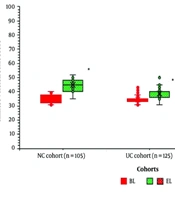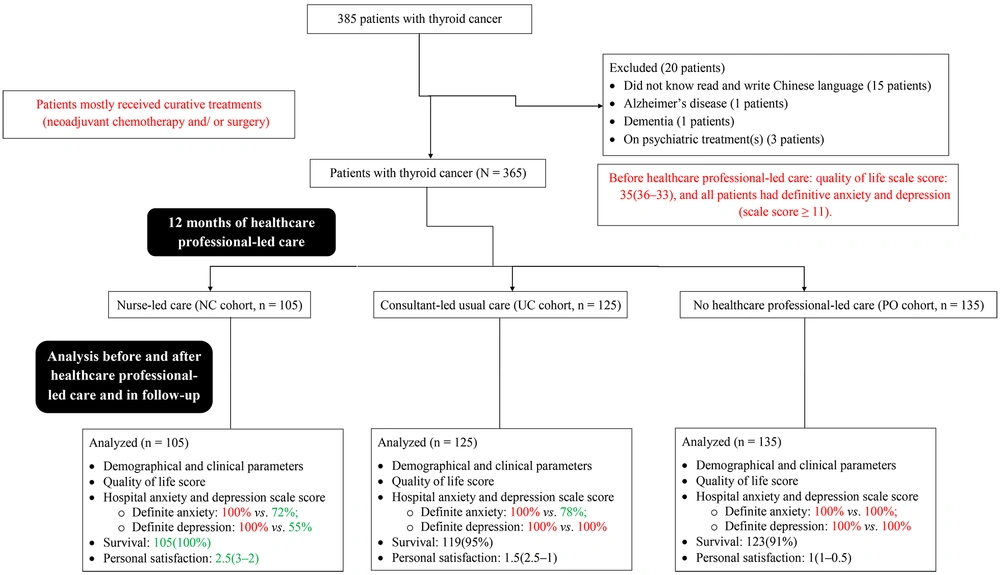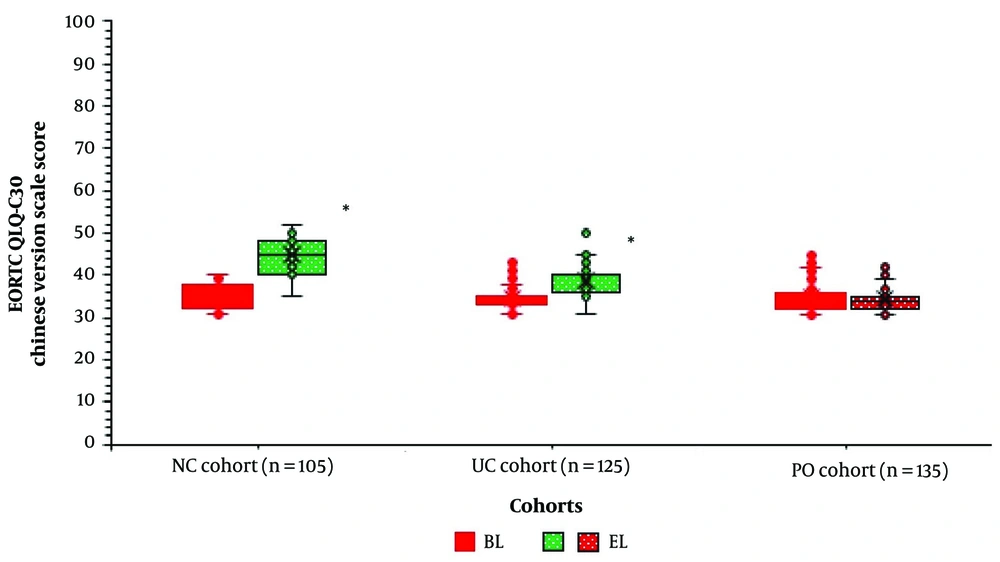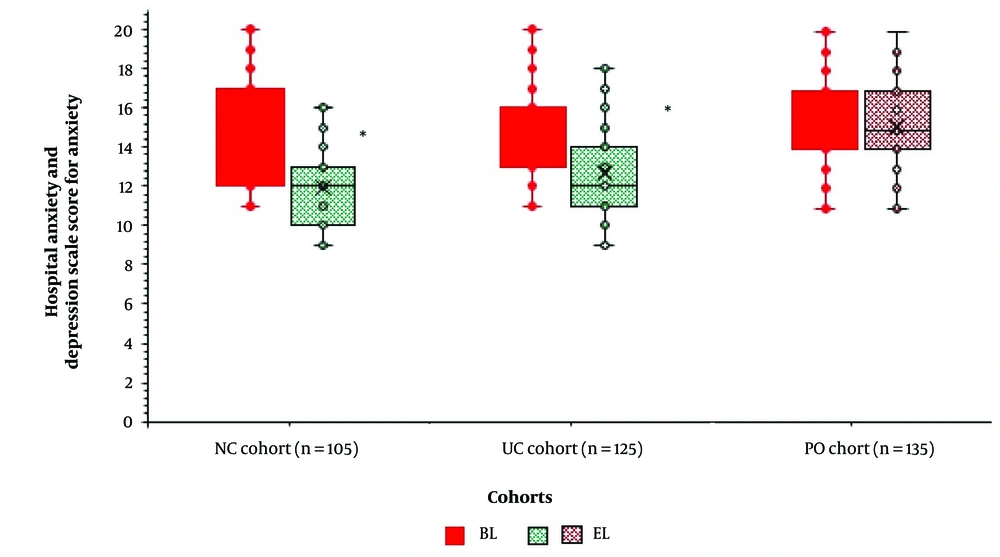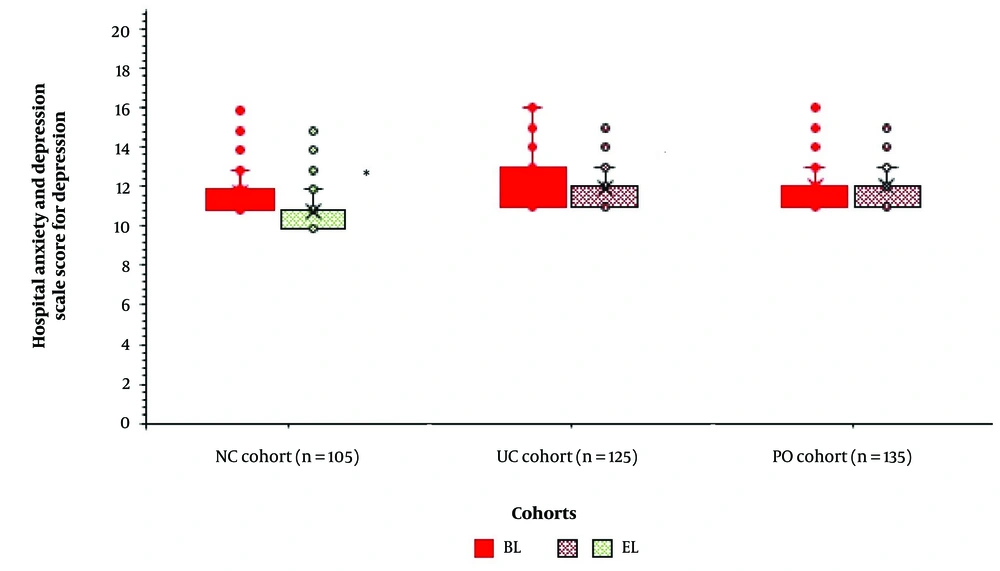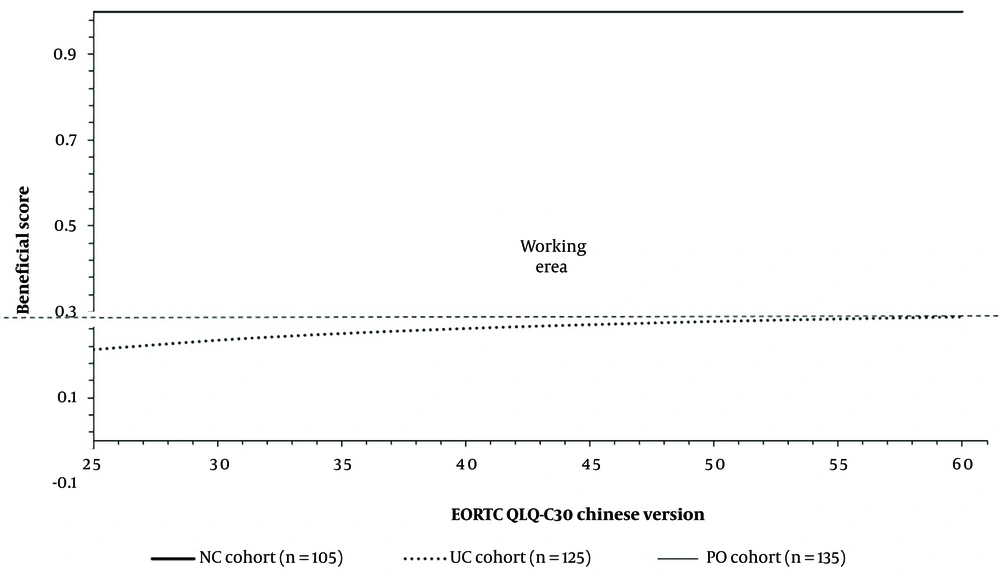1. Background
Thyroid cancer is generally detected in the initial stage and has a good prognosis, but survival depends on the type of cancer staging (1). Treatment of thyroid cancer includes hemi- or total-thyroidectomy, hormone replacement therapy, iodine replacement therapy, and long-term monitoring through blood exams and imaging examinations (2). Patients with thyroid cancer mostly receive treatments on time but have adverse effects such as nausea, alopecia, and mucositis (3). In addition, thyroid hormone dysregulation creates psychological issues, such as anxiety and depression, which may affect the quality of life of patients receiving treatment for thyroid cancer (4-6). Moreover, the prognosis of thyroid cancer treatment is unsatisfactory in the presence of different independent parameters, such as older age, which may worsen the quality of life and mental health of patients (7, 8). Therefore, it is necessary to improve the quality of life and mental health of patients with thyroid cancer. Psycho-oncological support and supportive care can be more effective in patients with thyroid cancer (9). Psychological consequences and timely intervention become crucial including both physical and emotional aspects to ensure holistic care for affected individuals with thyroid cancer.
The medical follow-up of patients with cancer might differ from country to country. For instance, in Brazil, in private clinics, the follow-up of patients with cancer is mainly done by consultants. However, consultant-led aftercare is necessary for patients with cancer during follow-up to detect adverse effects and cancer recurrence (10). Nurse-led care during follow-up has beneficial effects on the quality of life of patients with cancer (11). Patient satisfaction is higher for nurse-led care than for consultant-led care (12). During follow-up, patients with thyroid cancer need counseling because of worse outcomes of treatments for thyroid cancer (13). A randomized clinical trial reported that nurse-led care after 8 weeks reduced anxiety, nausea, vomiting, and physiological pain and improved appetite of Chinese patients with thyroid cancer in the Northern most region after and during treatment with chemotherapy and radiotherapy (14). In addition, patients with thyroid cancer mostly received curative treatments, such as neoadjuvant chemotherapy or surgery. Neoadjuvant chemotherapy for thyroid cancer is not commonly used in Brazil. However, this is often a treatment offered to patients in China. There might be relevant differences in guidelines for thyroid cancer treatments across the countries. Thus, interventions on nurse-led care versus consultant-led usual care in patients with thyroid cancer need to be studied.
2. Objectives
The objectives of this retrospective analysis were to evaluate the quality of life, anxiety, depression, survival, and personal satisfaction of Chinese patients in the Southeastern region of China with thyroid cancer, who received nurse-led care at the institute during the treatment of thyroid cancer and a follow-up period of 12 months against those of patients who received consultant-led usual care at the institute during the treatment of thyroid cancer and a follow-up period of 12 months and those of patients who did not receive healthcare professional-led care at the institute during treatment and a follow-up period of 12 months.
3. Methods
3.1. Ethics Approval and Consent to Participate
The retrospective design of the current study from available data of patients with thyroid cancer was made by the authors, and the protocols of the study were approved by the Human Ethics Committee of the First Affiliated Hospital of Soochow University and the Oncology Nursing Committee of Chinese Nursing Associations (approval number FAHSU dated June 15, 2022). The study follows the laws of China and the v2008 Declarations of Helsinki. As this was a retrospective analysis, the informed consent of patients was waived by the Human Ethics Committee of the First Affiliated Hospital of Soochow University.
3.2. Inclusion Criteria
Patients aged 18 years and above with biopsy-confirmed thyroid cancer and taking treatment at institutes that are easy-to-write and read Chinese language were included in the study.
3.3. Exclusion Criteria
Patients diagnosed with Alzheimer’s disease, dementia, or psychiatric treatment(s) were excluded from the study. Patients who were unable to read or write the Chinese language were excluded from the study.
3.4. Sample Size Calculation
The sample size was calculated based on the assumption that a minimum of 10% of the quality of life scores of patients would be improved after 12 months of follow-up with treatment intervention(s) with or without non-treatment intervention(s) as compared to before the treatment of thyroid cancer and the follow-up period. In addition, the 95% confidence interval and 80% power were calculated. The sample size (n) of the study (minimum number of patients required per arm) was 100.
3.5. Cohorts
A total of 105 patients received half an hour of nurse-led care, including counseling and aerobic exercise, at the institute during the treatment of thyroid cancer and a follow-up period of 12 months (NC cohort). A total of 125 patients received consultant-led usual care with information regarding the treatment(s) and adverse effects of thyroid cancer and aerobic exercise at the institute during treatment and a follow-up period of 12 months (UC cohort). A total of 135 patients did not receive any healthcare professional-led care or aerobic exercise at the institute during the treatment of thyroid cancer and the follow-up period of 12 months. These patients received visual aids and literature regarding thyroid cancer, treatment(s), and the adverse effects of treatment (PO cohort). Patients of the PO cohort were not being treated in parallel in other healthcare institutes that provide support. Whether a patient received nurse-led or consultant-led care or others decided on the availabilities of healthcare professionals.
3.6. Professional-Led Care
3.6.1. Nurse-Led Care
This is a session of 30 minutes when patients arrive at the hospital for the treatment of thyroid cancer, chemotherapy, and/or radiotherapy. Patients may call the nursing staff for any issue related to thyroid cancer. Nurses would take a history of patients, develop relationships with patients, and make them aware of the adverse effects of treatment(s) for thyroid cancer, chemotherapy, and/or radiotherapy. They also educated them on how to overcome the adverse effects of treatment, chemotherapy, and/or radiotherapy.
3.6.2. Consultant-Led Usual Care
This is a session of 25 minutes when patients arrive at the hospital for the treatment of thyroid cancer, chemotherapy, and/or radiotherapy. Consultants would take a history of patients and make them aware of the treatments and adverse effects of treatment for thyroid cancer, chemotherapy, and/or radiotherapies.
3.7. Aerobic Exercises
This session is mostly run with the institute side by side and includes Western aerobic exercise and Tai Chi martial arts. A trained instructor guided the patients regarding aerobic exercises.
3.8. Outcome Measures
The data was collected from patients’ medical records/electronic medical records.
3.9. Demographical and Clinical Parameters
Demographic, clinical, and socioeconomic parameters were collected from the hospital records of the patients and analyzed.
3.10. Quality of Life
The Chinese version of the European Organization for Research and Treatment of Cancer Quality of Life Questionnaire (EORTC QLQ-C30) was used to evaluate the patient’s quality of life. A total of 30 questions for 5 functional dimensions (physical, emotional, role, cognitive, and social) and 3 symptom dimensions (fatigue, pain, and nausea/vomiting) were administered by the nursing staff to patients. The total possible score was 100. The higher the score, the higher the quality of life of the patients (15). Instrumentation calculates a raw score and, then, linear transformation for the EORTC QLQ-C30.
3.11. Hospital Anxiety and Depression Scale
Anxiety and depression were evaluated, using the Hospital Anxiety and Depression Scale. This questionnaire included 7 questions. Each question has 4 answers (0, 1, 2, and 3). The total score was 21. Anxiety and depression were defined as scores ≥ 7. 0 - 7: No anxiety/depression, 7 - 10: Mild anxiety/depression, 11 - 21: Definite anxiety and depression (16).
Questionnaires of quality-of-life scores, hospital anxiety, and depression scale were administered before healthcare professional-led care (baseline before treatment or before a session with a nurse or consultant or similar time point) and after 12 months of healthcare professional-led care to patients with thyroid cancer.
3.12. Survival
Numbers of patients with overall survival within 1 year were collected and analyzed. This was collected via hospital records.
3.13. Personal Satisfaction of Patients
Patient satisfaction was evaluated after 12 months of treatment intervention(s) with or without professional-led care. Hospitals have their own printed format for the personal satisfaction of patients. There were 3 answers to the personal satisfaction of patients. Completely satisfied: 1; partially satisfied: 0.5; completely dissatisfied: 0. The patients’ personal satisfaction was assessed for (1) for healthcare professionals, (2) facilities available in hospitals, (3) attitudes of the staff, (4) aerobic exercise instructors. The total possible score was (4) the patients’ personal satisfaction ranged from 0 to 4. The higher the score, the higher the personal satisfaction of the patients. Satisfaction was for entire treatments including care being measured versus nurse or consultant care. Administration of measures were all at the same time.
3.14. Clinical Benefits for Treatment of Thyroid Cancer with 12 Months of Aftercare
Clinical benefits for healthcare professional-led care for patients with thyroid cancer care were evaluated as a function of the beneficial scores. The beneficial scores for healthcare professional-led care were calculated from the risk of under-aftercare as expressed in Equation 1. The risk of under-aftercare was defined with a calculation that involves the quality of life score, above which healthcare professional-led care was given for patients with thyroid cancer (Equation 2). The quality of life scores were considered as a numerical value from 25 to 60. The beneficial score of the healthcare professional-led care is the area above the curve of the aftercare method adopted and the working area is the area under the curve of that adopted aftercare method. For all adopted aftercare methods, more than 10% of scores differences in the quality of life scores after 12 months of healthcare professional-led care for patients with thyroid cancer (with regards to the quality of life scores of patients of the PO cohort before the treatment of thyroid cancer and the follow-up period) were used as the reference standard (17).
Equation 1:
Beneficial score = (number of patients with more than 10% the quality of life scores difference/ Total number of patients) – (Number of patients with less than 10% the quality of life scores difference/ Total number of patients) × Risk of under aftercare
3.15. Statistical Analyses
GraphPad Software Inc., (version 3.01, San Diego, CA, USA) was used for statistical analyses. Categorical variables are presented as frequencies with percentages in parentheses. Continuous normal variables and ordinal data are presented as mean ± standard deviation (SD). Continuous, non-normal variables and ordinal data are depicted as medians with Q3-Q1 in parentheses. For categorical variables, Fisher’s exact test or chi-square test (χ2-test) for independence (if required) was used (for sample size > 5 and total sample > 40). The Kolmogorov-Smirnov method was used to check the normality of the continuous or ordinal variables. Mann-Whitney test, Wilcoxon matched-pairs signed-ranks test, or Kruskal-Wallis’ test [nonparametric ANOVA (analysis of variance)] following Dunn’s multiple comparison tests were performed for non-linear continuous variables and ordinal data. All results were considered significant if the P-value was less than 0.05 at a 95% confidence interval.
4. Results
4.1. Study Population
From December 15, 2020, to June 14, 2022, a total of 385 patients aged 18 years and above with biopsy-confirmed thyroid cancer (the diagnosis was made on biopsies, taking into account both fine needle aspiration biopsies and surgery) received treatment at the First Affiliated Hospital of Soochow University, Suzhou, Jiangsu, China. Among them, 15 patients did not know how to read and write the Chinese language very well, 1 patient had Alzheimer’s disease, 1 patient had dementia, and 3 patients were under psychiatric treatment(s). Therefore, data from these patients (20 patients with thyroid cancer) were excluded from the analysis. Demographic and clinical parameters, quality of life scores, hospital anxiety and depression scale scores, survival, and personal satisfaction of 365 patients with thyroid cancer were included in the analysis. The study flowchart for the retrospective analysis is presented in Figure 1.
4.2. Demographical and Clinical Parameters
A total of 59% of female and 41% of male patients were included in the analysis. A total of 56 patients (60 - 48 years of age) were included in this study. A total of 96% of patients were married. Patients have primitive or higher education. Gender, age, marital status, and educational status were comparable among cohorts before healthcare professional-led care (P > 0.05). Details of the demographic and social parameters before the treatment of thyroid cancer and the follow-up period are presented in Table 1.
| Health Professional for Cancer Supportive Care | Total (N = 365) | Cohorts | Comparisons Among Cohorts | |||
|---|---|---|---|---|---|---|
| NC (n = 105) | UC (n = 125) | PO (n = 135) | ||||
| - | Nurse | Consultant | None | P-Value | df | |
| Gender | 0.9032 (χ2-test of independence) | 2 | ||||
| Female | 215 (59) | 60 (57) | 75 (60) | 80 (59) | - | - |
| Male | 150 (41) | 45 (43) | 50 (40) | 55 (41) | - | - |
| Age (y) | 56 (60 - 48) | 54 (59 - 50) | 58 (60 - 49) | 56 (60 - 45) | 0.1032 (Kruskal-Wallis’ test) | N/A |
| Marital status | 0.9168 (χ2-test of independence) | 2 | ||||
| Married | 350 (96) | 100 (95) | 120 (96) | 130 (96) | - | - |
| Single | 15 (4) | 5 (5) | 5 (4) | 5 (4) | - | - |
| Educational status | 0.2435 (χ2-test of independence) | 6 | ||||
| Primary | 44 (12) | 10 (10) | 18 (14) | 16 (12) | - | - |
| Secondary | 145 (40) | 40 (38) | 50 (40) | 55 (41) | - | - |
| Higher secondary | 104 (28) | 30 (28) | 37 (30) | 37 (27) | - | - |
| Graduate and above | 72 (20) | 25 (24) | 20 (16) | 27 (20) | - | - |
The quality of life of patients with thyroid cancer was diminished [EORTC QLQ-C30 Chinese version scale score: 35 (36 - 33)] before the treatment of thyroid cancer and the follow-up period [with or without non-treatment intervention(s); professional-led care]. Before the non-treatment intervention(s), all patients had definitive anxiety and depression (hospital anxiety and depression scale score ≥ 11). Body Mass Index, treatment-related parameters, comorbidities, EORTC QLQ-C30 Chinese version scale score, and hospital anxiety and depression scales for anxiety and depression were comparable among patients of cohorts before the treatment of thyroid cancer and the follow-up period (P > 0.05 for all). Data on the types of thyroid cancer before the treatment of thyroid cancer and the follow-up period and subgrouping based on what treatment patients received were comparable among patients of cohorts (P > 0.05 for all). Details of the disease- and treatment-related parameters before the treatment of thyroid cancer and the follow-up period are reported in Table 2.
| Parameters | Total (N = 365) | Cohorts | Comparisons Among Cohorts | |||
|---|---|---|---|---|---|---|
| NC (n = 105) | UC (n = 125) | PO (n = 135) | ||||
| - | Nurse | Consultant | None | P-Value | df | |
| Health Professional for Supportive Cancer Care | ||||||
| Body Mass Index (kg/m2) | 24.5 (25 - 24) | 24.5 (25 - 24) | 25 (25 - 24) | 24.5 (25 - 24) | 0.6747 (Kruskal-Wallis’ test) | N/A |
| Co-morbidities | 29 (8) | 7 (5) | 11 (9) | 11 (8) | 0.8323 (χ2-test of Independence) | 2 |
| Treatments | 0.8263 (χ2-test of independence) | 6 | ||||
| Neoadjuvant | 19 (5) | 5 (5) | 7 (6) | 7 (5) | ||
| Surgery | 150 (41) | 45 (43) | 55 (44) | 50 (37) | ||
| Adjuvant chemotherapy | 45 (12) | 15 (14) | 15 (12) | 15 (11) | ||
| Adjuvant chemoradiotherapy | 151 (42) | 40 (38) | 48 (38) | 63 (47) | ||
| EORTC QLQ-C30 Chinese version d | 35 (36 - 33) | 35 (38 - 32.5) | 35 (35 - 33) | 34 (36 - 32) | 0.286 (Kruskal-Wallis’ test) | N/A |
| Hospital Anxiety and Depression Scale Score e | ||||||
| Anxiety Scale | 0.1644 (Kruskal-Wallis’ test) | N/A | ||||
| Mean (Q3 - Q1) | 15 (17 - 13) | 14 (17 - 12) | 14 (16.5 - 13) | 15 (17 - 13) | ||
| No anxiety | (0) | (0) | (0) | (0) | ||
| Mild anxiety | (0) | (0) | (0) | (0) | ||
| Definite anxiety | 365 (100) | 105 (100) | 125 (100) | 135 (100) | ||
| Depression Scale | 0.069 (Kruskal-Wallis’ test) | N/A | ||||
| Mean (Q3 - Q1) | 12 (12.5 - 11) | 12 (12 - 11) | 12 (13 - 11) | 12 (12 - 11) | ||
| No depression | (0) | (0) | (0) | (0) | ||
| Mild depression | (0) | (0) | (0) | (0) | ||
| Definite depression | 365 (100) | 105 (100) | 125 (100) | 135 (100) | ||
4.3. Outcome Measures
4.3.1. Quality of Life
After 12 months of healthcare professional-led care in the NC and UC cohorts (P < 0.001 for both, Kruskal-Wallis’ test/ Dunn’s multiple comparison test), their quality of life improved as compared to them before healthcare professional-led care conditions, respectively. However, the quality of life of patients in the PO cohort did not improve compared to that before the treatment of thyroid cancer and the follow-up period conditions (P = 0.3622, Mann-Whitney test). The details of the EORTC QLQ-C30 Chinese version scale scores are shown in Figure 2. After 12 months of healthcare professional-led care, patients in the NC cohort had improved quality of life compared to those in the UC and PO cohorts. After 12 months of healthcare professional-led care, patients in the UC cohort had improved quality of life compared to those in the PO cohort after the treatment of thyroid cancer and the 12-month follow-up period.
Quality of life of patients with thyroid cancer. The total score of EORTC QLQ-C 30 was 100. A higher score indicated a higher quality of life. BL: Before the treatment of thyroid cancer and the follow-up period; EL: After the treatment of thyroid cancer and the follow-up period (12 months of healthcare professional-led care). * Significantly higher than BL. Upper whisker: Maximum value, upper box line: Third quartile value, x: Median value, lower box line: First quartile value, lower whisker: Minimum value. Red color indicates worse score of EORTC QLQ-C 30. Green color indicates good score of EORTC QLQ-C 30 after 12 months of treatment of thyroid cancer with healthcare professional-led care. Black indicates no improvements in score of EORTC QLQ-C 30.
4.4. Hospital Anxiety and Depression Scale
4.4.1. Anxiety Scale Score
After 12 months of healthcare professional-led care, patients in the NC and UC cohorts (P < 0.001 for both, Kruskal-Wallis’ test/ Dunn’s multiple comparison test) showed decreased anxiety as compared to them before healthcare professional-led care conditions, respectively. However, patients in the PO cohort did not show decreased anxiety compared to them before the treatment of thyroid cancer and the 12-month follow-up period (P > 0.9999, Wilcoxon matched-pairs signed-ranks test). The details of the anxiety scale scores for the hospital anxiety and depression scales are presented in Figure 3.
Anxiety scale score for Hospital Anxiety and Depression Scale. The total score is 21. 0 - 7: No anxiety, 7 - 10: Mild anxiety, and 11 - 21: Definite anxiety. BL: Before the treatment of thyroid cancer and the follow-up period, EL: After 12 months of healthcare professional-led care. * Significantly lower than BL. Upper whisker: Maximum value, upper box line: Third quartile value, x: Median value, lower box line: First quartile value, lower whisker: Minimum value. Red color indicates worse score of anxiety. Green color indicates good score of anxiety after 12 months of treatment of thyroid cancer with healthcare professional-led care. Black indicates no improvements in the score of anxiety.
After 12 months of healthcare professional-led care, none of the patients had any anxiety; 29 (28%), 27 (22%), and 0 (0%) patients had mild anxiety; and 76 (72%), 98 (78%), and 135 (100%) patients had definite anxiety in the NC, UC, and PO cohorts, respectively. After 12 months of healthcare professional-led care, patients in the NC cohort showed decreased anxiety compared to those in the UC and PO cohorts (P < 0.001 for both, Kruskal-Wallis’ test/Dunn’s multiple comparison test). After 12 months of healthcare professional-led care, the NC and UC cohorts had higher numbers of patients with mild anxiety than the PO cohort. After 12 months of healthcare professional-led care, the NC and UC cohorts had statistically the same number of patients with mild and severe anxiety.
4.4.2. Depression Scale
After 12 months of healthcare professional-led care, patients in the NC cohort (P < 0.001, Kruskal-Wallis’ test/Dunn’s multiple comparison test) showed decreased depression compared to before healthcare professional-led care. After 12 months of healthcare professional-led care, patients in the UC and PO cohorts failed to show a decrease in depression as compared to them before the treatment of thyroid cancer and the follow-up period with or without healthcare professional-led care conditions, respectively (P > 0.05, Kruskal-Wallis’ test/Dunn’s multiple comparison test). The details of the depression scale scores for the hospital anxiety and depression scales are presented in Figure 4.
Depression Scale score for Hospital Anxiety and Depression Scale. The total score is 21. 0 - 7: No depression, 7 - 10: Mild depression, and 11 - 21: Definite depression. BL: Before the treatment of thyroid cancer and the follow-up period with or without healthcare professional-led care, EL: After 12 months of treatment of thyroid cancer and the follow-up period with or without healthcare professional-led care. * Significantly lower than BL. Upper whisker: Maximum value, upper box line: Third quartile value, x: Median value, lower box line: First quartile value, lower whisker: Minimum value. Red color indicates worse score of depression. Green color indicates good score of depression after 12 months of treatment of thyroid cancer with healthcare professional-led care. Black indicates no improvements in the score of depression.
After 12 months of healthcare professional-led care, none of the patients had any depression; 47 (45%), 0 (0%), and 0 (0%) had mild depression; and 58 (55%), 125 (100%), and 135 (100%) patients had definitive depression from the NC, UC, and PO cohorts, respectively. After 12 months of healthcare professional-led care, patients in the NC cohort had decreased depression compared to those in the UC and PO cohorts (P < 0.001 for both, Kruskal-Wallis’ test/Dann’s multiple comparison test). After 12 months of healthcare professional-led care, the NC cohort had a higher number of patients with mild depression and fewer patients with definitive depression than the UC and PO cohorts. After 12 months of healthcare professional-led care, the UC and PO cohorts had the same number of patients with mild and definitive depression.
4.5. Survival
A total of 105 (100%), 119 (95%), and 123 (91%) patients survived in the NC, UC, and PO cohorts, respectively, during the follow-up period (1 year). A higher number of patients survived in the follow-up from the NC cohort than in the UC and PO cohorts.
4.6. Personal Satisfaction of Patients
The personal satisfaction of the patients was higher in the NC cohort than in the UC and PO cohorts. The personal satisfaction of the patients was higher in the UC cohort than in the PO cohort.
The details of the outcome measures after 12 months of healthcare professional-led care are presented in Table 3.
| Parameter | Total (N = 365) | Cohorts | Comparison Between UC and PO | ||||
|---|---|---|---|---|---|---|---|
| NC (n = 105) | Cohorts UC (n = 125) | PO (n = 135) | |||||
| - | Nurse | P-Value d | Consultant | P-Value d | None | P-Value | |
| Health Professional for Cancer Supportive Care | |||||||
| EORTC QLQ-C30 Chinese version scale score e | 40 (42 - 35) | 45 (48.5 - 40) | < 0.001 (Kruskal - Wallis’ test/Dunn’s multiple comparison test) | 40 (40 - 35.5) | < 0.001 (Kruskal-Wallis’ test/Dunn’s multiple comparison test) | 34 (35 - 32) | < 0.001 (Kruskal-Wallis’ test/Dunn’s multiple comparison test) |
| Hospital Anxiety and Depression Scale Score f | |||||||
| Anxiety Scale | |||||||
| Medians (Q3 - Q1) | 15 (13 - 11) | 12 (13.5 - 10) | < 0.001 (Kruskal-Wallis’ test/Dunn’s multiple comparison test) | 12 (14.5 - 11) | < 0.001 (Kruskal-Wallis’ test/Dunn’s multiple comparison test) | 15 (17 - 13) | < 0.001 (Kruskal-Wallis’ test/Dunn’s multiple comparison test) |
| No anxiety | (0) | (0) | 0.3654 (χ2-test) | (0) | < 0.0001 (Fisher exact test) | (0) | < 0.0001 (Fisher exact test) |
| Mild anxiety | 56 (15) | 29 (28) | 27 (22) | (0) | |||
| Definite anxiety | 309 (85) | 76 (72) | 98 (78) | 135 (100) | |||
| Depression Scale | |||||||
| Medians (Q3-Q1) | 12 (12 - 11) | 11 (11 - 10) | < 0.001 (Kruskal-Wallis’ test/Dunn’s multiple comparison test) | 12 (12 - 11) | > 0.05 (Kruskal-Wallis’ test/Dunn’s multiple comparison test) | 12 (12 - 11) | > 0.05 (Kruskal-Wallis’ test/Dunn’s multiple comparison test) |
| No depression | (0) | (0) | < 0.0001 (Fisher exact test) | (0) | < 0.0001 (Fisher exact test) | (0) | N/A |
| Mild depression | 47 (12) | 47 (45) | (0) | (0) | |||
| Definite depression | 318 (88) | 58 (55) | 125 (100) | 135 (100) | |||
| Survival | 347 (95) | 105 (100) | 0.0327 (Fisher exact test) | 119 (95) | 0.0014 (Fisher exact test) | 123 (91) | 0.2277 (Fisher exact test) |
| Personal satisfaction of patients g | 1.5 (2.5 - 1) | 2.5 (3 - 2) | < 0.001 (Kruskal-Wallis’ test/Dunn’s multiple comparison test) | 1.5 (2.5 - 1) | < 0.001 (Kruskal-Wallis’ test/Dunn’s multiple comparison test) | 1 (1 - 0.5) | < 0.001 (Kruskal-Wallis’ test/Dunn’s multiple comparison test) |
4.7. Clinical Benefits for Treatment of Thyroid Cancer with 12 Months of After Care
Working areas for patients were 0 - 1 beneficial score for > 0 EORTC QLQ-C30 Chinese version scale, 0 - 0.29 beneficial score for patients with > 25 EORTC QLQ-C30 Chinese version scale, and none for all patients of the NC, UC, and PO cohorts, respectively. Less than 25 EORTC QLQ-C30 Chinese version scale, less than 65 EORTC QLQ-C30 Chinese version scale, and none for any scale patients of the UC, PO, and NC cohorts had a risk of under aftercare. The details of the clinical benefits of treatment of thyroid cancer with 12 months of aftercare with or without healthcare professional-led care are presented in Figure 5 and Table 4.
The clinical benefits for treatment of thyroid cancer with 12 months of aftercare with or without healthcare professional-led care. The working area is the area under the curve of that adopted aftercare method. For all adopted aftercare methods, more than 10 score differences in the quality of life scores after 12 months of follow-up with healthcare professional-led care for patients with thyroid cancer were used as the reference standard.
| EORTC QLQ-C30 Chinese Version | Beneficial Score | ||
|---|---|---|---|
| NC Cohort (n = 105) | UC Cohort (n = 125) | PO Cohort (n = 135) | |
| Nurse | Consultant | None | |
| Health Professional for Cancer Supportive Care | |||
| Numbers of patients with ≥ 10% difference of EORTC QLQ-C30 Chinese version scale (primary objective) | 105 | 84 | 15 |
| Numbers of patients with < 10% difference of EORTC QLQ-C30 Chinese version scale | 0 | 41 | 120 |
| 25 | 1 | 0.21 | -1.13 |
| 30 | 1 | 0.23 | -1.07 |
| 33 | 1 | 0.24 | -1.05 |
| 35 | 1 | 0.25 | -1.03 |
| 37 | 1 | 0.26 | -1.02 |
| 40 | 1 | 0.26 | -1 |
| 43 | 1 | 0.27 | -0.98 |
| 48 | 1 | 0.28 | -0.96 |
| 50 | 1 | 0.28 | -0.96 |
| 55 | 1 | 0.28 | -0.94 |
| 60 | 1 | 0.29 | -0.93 |
| Working area for patients | 0 - 1 beneficial score for > 0 EORTC QLQ-C30 Chinese version scale | 0 - 0.29 beneficial score for patients with > 25 EORTC QLQ-C30 Chinese version scale | None for all patients |
| Risk of under aftercare for patients with QoL score | None for any scale | < 25 EORTC QLQ-C30 Chinese version scale | < 65 EORTC QLQ-C30 Chinese version scale |
Clinical Benefits for Treatment of Thyroid Cancer with 12 Months of Aftercare with or Without Healthcare Professional-Led Care a
5. Discussion
Before healthcare professional-led care, all patients had a diminished quality of life and definitive anxiety and depression. The quality of life and psychological conditions of patients before healthcare professional-led care are consistent with those of an observational study (9), a survey (13), a randomized controlled trial (14), and a population-based survey (15). The patients included in the current study mostly received curative treatments, such as neoadjuvant chemotherapy and/or surgery. Before this treatment, the patients had never been admitted to the hospital for chemotherapy treatment(s). The hospital environment affects patients’ quality of life and emotions (14). Supportive care after surgery and during treatment(s) for thyroid cancer during the follow-up period is necessary for patients with thyroid cancer.
The quality of life and psychological conditions of patients improved after 12 months if they received nurse-led care. Consultants are busy with new patients with cancer. Therefore, it is difficult to provide the proper time for patients in follow-up care (10) (the time provided for sessions was similar for nurse-led care and consultant-led care. There was a big difference in the number of patients each healthcare professional is responsible for nurse-led care improves the enthusiasm of patients for participating in family functions. This leads to improved quality of life and emotions in patients with thyroid cancer (18). Only nurse-led care had beneficial effects on the quality of life and psychological conditions of patients with thyroid cancer during the follow-up period.
The personal satisfaction of the patients was higher in the NC cohort than in the UC and PO cohorts. The results of the personal satisfaction of patients in the current study were consistent with those of a survey (12). Nurse-led care creates stronger relationships than consultant-led care, which leads to greater satisfaction for patients with thyroid cancer (18). In practical means, the time provided for each session was slightly different. In addition, patients could call the nursing staff for any issue related to thyroid cancer. Nurse-led care has higher personal satisfaction than any consultant-led care for patients with thyroid cancer. However, there is a paucity of data on this topic and further studies are needed.
The quality of life and psychological conditions of patients also improved after 12 months if they received consultant-led care. The quality of life of patients before healthcare professional-led care was diminished, and patients experienced definitive anxiety. In worse psychological conditions and quality of life condition(s) of patients, consultant-led care is also successful in improving quality of life and anxiety.
Only patients in the NC cohort had 100% survival. When patients with thyroid cancer receive nurse-led care along with treatment intervention(s), they may feel better, have a better quality of life, have fewer negative emotions, and live longer. Nurse-led care during follow-up may improve the survival of patients with thyroid cancer.
A maximum of 9% of deaths were reported in the PO cohort. A 30-minute session of nurse-led care or a 25-minute session of consultant-led usual care could not affect patients’ survival. Further studies are needed on this topic that which factors affect the death of patients with thyroid cancer.
The study might be regarding an important issue in thyroidology. However, there are limitations of this study including its non-randomized, non-treatment, retrospective design and the lack of randomized non-treatment trials. In the other limitations, for example, a single center study. There are some particularities of nurse training and their role in different countries. A small sample size leads to type II errors.
5.1. Conclusions
Supportive care after surgery or during treatment and follow-up is necessary for patients with thyroid cancer. Only nurse-led care had beneficial effects on the quality of life and psychological conditions of patients with thyroid cancer during the follow-up period. Nurse-led care has higher personal satisfaction than any consultant-led care for patients with thyroid cancer. Nurse-led care during follow-up may improve the survival of patients with thyroid cancer. Consultant-led care is also successful in improving quality of life and psychological behavior if patients with thyroid cancer have worse physical and psychological conditions.
